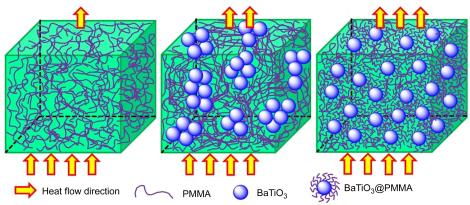| [1] Barrett, J. Microelectron. Reliab. 1998, 38, 1277.
[2] Garimella, S. V.; Lian-Tuu, Y.; Persoons, T. IEEE Trans. Comp. Pack. Man. 2012, 2, 1307.
[3] Otiaba, K. C.; Ekere, N. N.; Bhatti, R. S.; Mallik, S.; Alam, M. O.; Amalu, E. H. Microelectron. Reliab. 2011, 51, 2031.
[4] Yavatkar, R.; Tirumala, M. Microelectron. J. 2008, 39, 930.
[5] T'Joen, C.; Park, Y.; Wang, Q.; Sommers, A.; Han, X.; Jacobi, A. Int. J. Refrig. 2009, 32, 763.
[6] Lee, G. W.; Park, M.; Kim, J.; Lee, J. I.; Yoon, H. G. Composites Part A 2006, 37, 727.
[7] Zhou, W.; Qi, S.; Tu, C.; Zhao, H. J. Appl. Polym. Sci. 2007, 104, 2478.
[8] Pop, E.; Mann, D.; Wang, Q.; Goodson, K. E.; Dai, H. J. Nano Lett. 2006, 6, 96.
[9] Balandin, A. A.; Ghosh, S.; Bao, W.; Calizo, I.; Teweldebrhan, D.; Miao, F.; Lau, C. N. Nano Lett. 2008, 8, 902.
[10] Wang, S.; Tambraparni, M.; Qiu, J.; Tipton, J.; Dean, D. Macromolecules 2009, 42, 5251.
[11] Jezowski, A.; Mucha, J.; Pazik, R.; Strek, W. Appl. Phys. Lett. 2007, 90.
[12] Sato, K.; Horibe, H.; Shirai, T.; Hotta, Y.; Nakano, H.; Nagai, H.; Mitsuishi, K.; Watari, K. J. Mater. Chem. 2010, 20, 2749.
[13] Yung, K. C.; Liem, H. J. Appl. Polym. Sci. 2007, 106, 3587.
[14] Roy, A. K.; Farmer, B. L.; Varshney, V.; Sihn, S.; Lee, J.; Ganguli, S. ACS Appl. Mater. Interface 2012, 4, 545.
[15] Xu, Y.; Chung, D. D. L. Compos. Interface 2000, 7, 243.
[16] Liu, Q.; Zhang, Q.; Chen, S.; Zhou, J.; Lei, X. Chin. J. Org. Chem. 2012, 32, 1846 (in Chinese). (刘清, 张秋禹, 陈少杰, 周健, 雷星锋, 有机化学, 2012, 32, 1846.)
[17] Ren, C. H.; Jiang, X.; Lu, G. L.; Jiang, X. Y.; Huang, X. Y. J. Polym. Sci. Chem. 2014, 52, 1478.
[18] Cai, X.; Hu, W.; Lu, G.; Huang, X. Chin. J. Org. Chem. 2013, 33, 2520 (in Chinese). (蔡晓冰, 胡薇, 陆国林, 黄晓宇, 有机化学, 2013, 33, 2520.)
[19] Jiang, X. Y.; Li, Y. J.; Lu, G. L.; Huang, X. Y. Polym. Chem. 2013, 4, 1402.
[20] Xi, C. B.; Yang, D.; Li, J.; Yan, J. J.; Hu, J. H. Chin. J. Org. Chem. 2012, 32, 2166 (in Chinese). (席陈彬, 杨东, 李静, 晏建军, 有机化学, 2012, 32, 2166.)
[21] Sun, Q. W.; Yu, Y.; Zhang, N.; Zhang, F. Y. Chin. J. Org. Chem. 2012, 32, 889 (in Chinese). (孙庆文, 于颖, 张南, 张法永, 有机化学, 2012, 32, 889.)
[22] Song, X. M.; Yao, W. Q.; Lu, G. L.; Li, Y. J.; Huang, X. Y. Polym. Chem. 2013, 4, 2864.
[23] Li, B. Z.; Li, Y. H. Chin. J. Org. Chem. 2013, 33, 2148 (in Chinese). (李炳臻, 李义和, 有机化学, 2013, 33, 2148.)
[24] Liu, G. Z.; Han, D. E.; Wang, P.; Liu, H. M. Chin. J. Org. Chem. 2013, 33, 1674 (in Chinese). (刘改枝, 韩德恩, 王鹏, 刘宏民, 有机化学, 2013, 33, 1674.)
[25] Cui, L.; Tarte, N. H.; Woo, S. I. Macromolecules 2009, 42, 8649.
[26] Sun, Y. Y.; Zhang, Z. Q.; Wong, C. P. In Proceeding of 54th Electronic Components and Technology Conference, 2004, p. 754, p. 760.
[27] Hung, M. T.; Choi, O.; Ju, Y. S.; Hahn, H. T. Appl. Phys. Lett. 2006, 89.
[28] Convertine, A. J.; Lokitz, B. S.; Lowe, A. B.; Scales, C. W.; Myrick, L. J.; McCormick, C. L. Macromol. Rapid. Commun. 2005, 26, 791. |
